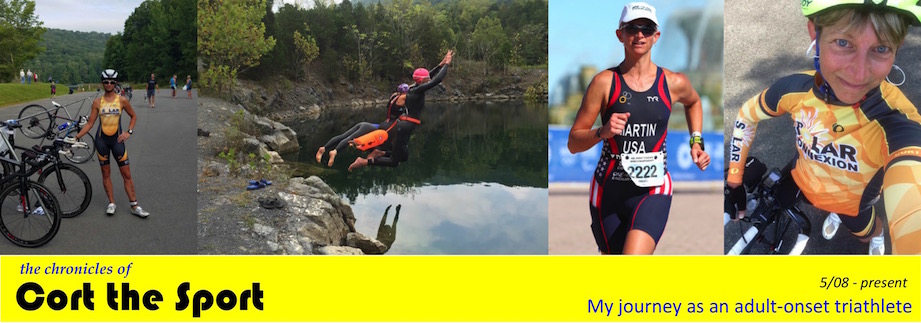After the marathon in November it was time to switch up the strength training program for the off-season. Kurt proposed a plan that focuses on race speed, particularly the bike and run. I thought I'd share part of this approach, particularly for those endurance athletes who have vowed to add strength training in for 2012!
The current split is:
- Power focused leg and back day – lower reps in the 6-8 range
- Chest, shoulders, arms
- Speed and Endurance focused leg day – higher reps 15-20 range
I want to talk specifically about the speed and endurance focused leg day. The purpose of this workout is to build explosive strength and speed, promote greater muscle recruitment, and to train the legs to maintain high leg turnover (cadence and speed) when fatigued. Here's Kurt's better explanation -
From Kurt Weidner: The goals behind the workout scheme with the speed and endurance-based leg day include:
- Elevate anaerobic endurance by forcing the muscles to perform under conditions of extreme fatigue.
- Exhaust the same muscles involved with running by performing anaerobic based resistance exercises in a high rep range and then asking the legs to turn over at a fast rate (running 2 hard laps in between exercises) immediately after...if you can get the legs to turn over and run circles (elevate knee, reach and snap the leg down followed by the buttkick...maintaining stride integrity) under conditions of muscular exhaustion/glycogen depletion (the resistance training utilizes glycolytic anaerobic pathway), then your body becomes conditioned to deal with this.
- Enable fatigued legs to perform and not just become conditioned for exhaustion. The high rep exercises chosen are performed with a focus on speed during the concentric part of the movement...we don't just want recruitment of muscle under conditions of exhaustion, we want rapid muscle fiber recruitment. It's not just important to get your legs to turn over, but to turn over with speed. Theoretically, if you can enable your legs to turn over at a fast rate, while maintaining stride integrity under conditions of exhaustion, then this should translate to a faster distance pace. We'll see what happens.
The general format is 3-4 working sets of a leg exercise in the 15-20 rep range, working on explosive power, and with minimal rest between sets (just enough to catch my breath a bit, mop up the sweat, and maybe groan a bit). As soon as the last set is finished, I’m up the stairs to do two laps of our 9-laps-to-a-mile track focusing on high cadence and turnover. While I’m running, he’s setting up the next exercise. And so it goes.
We focus on compound movements with free weights, cables, and a few machines that require motions and positions that are most similar to what is needed on the run or bike. A wider range of exercises and stances are incorporated on the power-focused leg day. Here are the general types of exercises that are used but note that there are countless variations of each.
- Deadlifts – trap bar, stiff-legged
- Squats, split squats, Bear squat, H squat
- Step-Ups
- Leg press
- Lunges
- Glute-ham exercises
Impact
The first time I did this workout was the first time I really thought I might throw up in the gym. After the workout, I ended up laying down on a mat for a while before I could compose myself to drive home. But I was excited!! I knew we had found a chink in the armor, and that meant I had a way to improve. Each week things have gotten better and I can tell I am adjusting and getting stronger and I am glad for the challenge.
Am I seeing results? I believe so. On my weekend run I was able to keep my average run cadence in the low 90's and maintain that throughout 12+ miles. In the past, it has tended to drop below 90 in later miles.
Integration with Swim/Bike/Run Training
Triathletes can be reluctant to incorporate strength training because (1) they are unsure of how integrate it into a swim/bike/run schedule and (2) they believe it will compromise those workouts. The body adapts to the demands. Certainly you want to be sure that you are fresh for key workouts and races, but in a normal training week the body can handle both strength and endurance training.
I work to hit the same body parts on the same day where possible, followed by a rest day. So I'll do this endurance focused leg workout on a day that I have a short or moderate run and an easy bike or a swim the following day. It’s better to hit parts hard in one day then give them recovery time than to pummel them day after day. Similarly, I’ll usually do the upper body day on a swim day.
Strength training can and should be integrated into an endurance program, particularly for master's athletes. The workout I described can be adapted to work with any equipment and facility so if you have vowed to integrate strength training for 2012, start with this style of workout!

